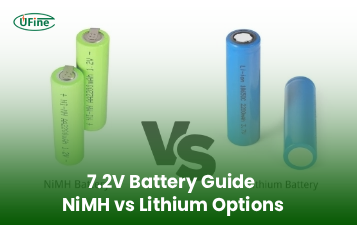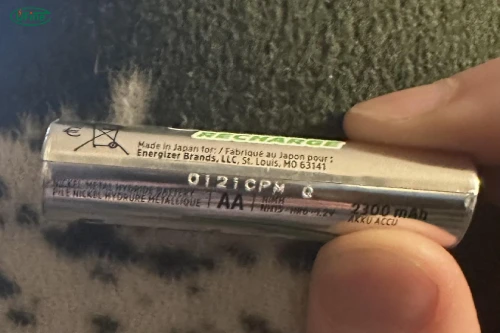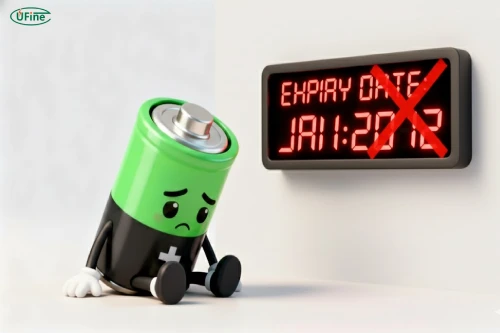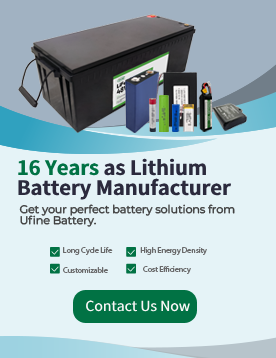
- Part 1. What does “Battery Expiration Date” mean?
- Part 2. How long do different types of batteries last?
- Part 3. What happens when a battery “Goes Out of Date”?
- Part 4. Signs that your battery is expired or aging
- Part 5. Do rechargeable batteries go out of date too?
- Part 6. How to read battery expiration dates and codes
- Part 7. Factors that shorten battery shelf life
- Part 8. How to store batteries for maximum lifespan
- Part 9. What happens if you use expired batteries?
- Part 10. Rechargeable vs. non-rechargeable: which lasts longer in storage?
- Part 11. Myths about battery expiration
- Part 12. FAQ
Quick Answer: Yes, batteries do go out of date. Every battery—whether alkaline, lithium, or rechargeable—has a finite shelf life. Over time, internal chemicals degrade, reducing capacity, voltage stability, and safety. Even unused batteries slowly lose charge or react chemically. Most disposable batteries last 5–15 years, while rechargeable types typically last 2–10 years, depending on their chemistry, quality, and storage conditions.
Part 1. What does “Battery Expiration Date” mean?
When you pick up a pack of batteries and see an expiration or “best before” date, it doesn’t mean the battery will instantly stop working after that date—it signals when performance may begin to degrade noticeably.
The expiration date usually indicates how long a battery can sit in storage before its capacity falls below a specified threshold (often 80% of its rated charge). Manufacturers determine this through accelerated aging tests under controlled temperature and humidity.
Two important concepts help clarify this:
- Shelf Life: How long a battery retains charge and remains usable while stored.
- Usable Life: How long it can power a device once in active use.
Battery chemistry plays the biggest role in determining these timelines.
Part 2. How long do different types of batteries last?
Different battery chemistries behave differently over time. Here’s how common types compare in both shelf life (unused) and cycle life (if rechargeable):
| Battery Type | Typical Shelf Life | Recharge Cycles | Notes |
|---|---|---|---|
| Alkaline | 5–10 years | N/A | Most common household battery; gradually loses power even when unused |
| Lithium (Primary) | 10–15 years | N/A | Longest shelf life; ideal for smoke alarms and backup systems |
| NiMH Rechargeable | 3–5 years | 500–1,000 cycles | Loses charge faster in storage but recharges easily |
| Li-ion Rechargeable | 2–10 years | 300–1,000 cycles | Sensitive to high temperatures; benefits from partial charge storage |
| Lead-Acid | 3–6 years | 300–500 cycles | Common in vehicles and solar systems; heavier and less energy-dense |
Part 3. What happens when a battery “Goes Out of Date”?
When batteries age, internal chemical changes slowly reduce their efficiency. Here’s what happens internally:
- Electrolyte breakdown: The chemicals that carry ions degrade, increasing internal resistance and reducing voltage output.
- Gas formation: Especially in older alkaline and zinc-carbon batteries, chemical byproducts create gas buildup, leading to leaks or bulging.
- Corrosion: Terminals can corrode, preventing a clean electrical connection.
- Capacity loss: The battery simply can’t store as much energy as before.
For rechargeable batteries, aging also causes capacity fade and higher self-discharge, meaning they lose stored energy faster even when not in use.
Part 4. Signs that your battery is expired or aging
Recognizing an expired battery early can prevent device damage. Here are common signs:
- Shorter runtime – Your flashlight or remote dies much faster than before.
- Swelling or bulging – Gas buildup inside rechargeable batteries (especially Li-ion) causes visible deformation.
- Leaking or corrosion – White or brown residue on terminals is a clear sign of electrolyte leakage.
- Overheating – Batteries that heat excessively during charging or use are nearing end-of-life.
- Inconsistent performance – Voltage drops cause devices to flicker or fail unexpectedly.
If you notice any of these, dispose of the battery properly—never throw it in household trash.
Part 5. Do rechargeable batteries go out of date too?
Yes, rechargeable batteries also age, but the mechanism differs from disposable types. Their lifespan depends on both time and usage:
- Cycle Aging: Each charge-discharge cycle slightly degrades internal materials. After hundreds of cycles, total capacity drops noticeably.
- Calendar Aging: Even unused, the chemicals slowly deteriorate over time.
Here’s how different rechargeable types age:
- NiMH (Nickel-Metal Hydride): Experiences higher self-discharge; loses about 15–30% of charge per month when stored.
- Li-ion (Lithium-ion): Sensitive to high heat and overcharging; stores best at 40–60% charge in a cool place.
- LiFePO4: Longer lifespan and better thermal stability—often exceeding 2,000–3,000 cycles.
Part 6. How to read battery expiration dates and codes
Battery packaging often includes a “Best Before” or “Use By” date printed near the barcode or bottom seam. For larger batteries, especially industrial or automotive, manufacturers may use date codes such as:
- YYMM – e.g., “2410” means manufactured in October 2024.
- Week-Year – e.g., “35-25” means week 35 of 2025.
If you can’t find an expiration date, you can often check the manufacturer’s website for decoding instructions. Reputable producers like Ufine Battery include clear batch tracking and manufacturing codes to ensure traceability.
Part 7. Factors that shorten battery shelf life
Even the best batteries degrade faster under poor conditions. Major factors include:
1 Temperature Extremes
Heat accelerates chemical reactions that lead to leakage and capacity loss. Cold slows reactions but can increase internal resistance. Store batteries at 10–25°C (50–77°F) for optimal results.
2 Humidity
Moisture can corrode terminals or penetrate seals, especially in cheaper alkaline batteries.
3 Deep Discharge
Letting rechargeable batteries drain to zero repeatedly reduces cycle life. Li-ion cells are especially vulnerable.
4 Overcharging
Keeping a battery on charge long after it’s full creates heat and pressure. Use smart chargers that automatically stop charging.
5 Low-Quality Manufacturing
Inconsistent materials and weak seals shorten shelf life dramatically. Choosing reputable brands like Ufine Battery ensures higher consistency and protection.
Part 8. How to store batteries for maximum lifespan
Proper storage dramatically extends battery life:
- Keep them cool and dry: Ideal temperature is around 15–20°C (59–68°F).
- Avoid direct sunlight or heat sources.
- Store in original packaging to prevent short-circuiting.
- Separate old and new batteries to avoid voltage mismatch.
- Partial charge storage for rechargeables: For Li-ion and NiMH, store at about 40–60% capacity if unused for long periods.
- Don’t refrigerate batteries unless specified by the manufacturer—condensation can cause corrosion.
Part 9. What happens if you use expired batteries?
Using expired or degraded batteries can lead to multiple issues:
- Leakage and corrosion damage to metal contacts or circuit boards
- Voltage drops that cause device malfunction
- Swelling or rupture in lithium-based batteries, posing a safety risk
- Reduced efficiency — even if they “work,” they won’t last as long per charge
If a device stops responding or you notice corrosion, remove all batteries immediately. Clean terminals with a small amount of vinegar or lemon juice (for alkaline corrosion), dry completely, and insert new batteries.
Part 10. Rechargeable vs. non-rechargeable: which lasts longer in storage?
Rechargeable and disposable batteries differ not just in reusability but also in shelf stability.
| Feature | Non-Rechargeable (Alkaline, Lithium) | Rechargeable (NiMH, Li-ion, LiFePO4) |
|---|---|---|
| Shelf Life | 5–15 years | 2–10 years |
| Voltage | 1.5V (AA, AAA) | 1.2V (NiMH), 3.6–3.7V (Li-ion) |
| Self-Discharge Rate | Very low | Moderate to high |
| Best For | Infrequent-use devices | Frequent-use electronics |
| Environmental Impact | Single-use waste | Recyclable, reusable |
Manufacturers like Ufine Battery produce advanced low self-discharge rechargeable batteries that bridge this gap—offering both long shelf life and reusability.
Part 11. Myths about battery expiration
Let’s debunk a few popular misconceptions:
❌ Myth 1: “Freezing batteries makes them last longer.”
This used to apply to older zinc-carbon types. Modern batteries can suffer condensation damage and lose performance if stored below freezing.
❌ Myth 2: “Rechargeable batteries never expire.”
They do—chemical aging and cycle degradation reduce capacity over time.
❌ Myth 3: “You can revive expired batteries by recharging or tapping them.”
Unsafe and ineffective. Degraded chemicals can leak or explode under pressure.
❌ Myth 4: “All batteries lose charge at the same rate.”
Each chemistry behaves differently; lithium-based cells have the best long-term retention.
Understanding these facts helps consumers make smarter, safer choices.
Part 12. FAQ
Do unopened batteries lose charge over time?
Yes, though slowly. Even unopened batteries undergo chemical reactions that reduce energy over years. Store them in cool, dry conditions to minimize this effect.
How can I safely dispose of expired batteries?
Take them to certified recycling centers or collection points. Avoid throwing batteries into household waste—improper disposal can release harmful metals into the environment.
Can using expired batteries damage my electronics?
Yes. Leakage and corrosion can harm battery terminals, wiring, or circuit boards. Always replace old batteries promptly and clean any residue before inserting new ones.
Do rechargeable batteries expire if I don’t use them?
Yes—chemical degradation continues even when unused, especially at high temperatures. To slow this, store them at partial charge and moderate temperatures.
How can I tell if a lithium-ion battery is still good?
Check for swelling, heat, or reduced runtime. If it charges abnormally fast or loses power quickly, it’s nearing end-of-life.
Are expired batteries dangerous?
They can be. Leaked electrolyte is corrosive, and swollen cells may rupture under pressure. Handle them carefully and recycle them safely.
Related Tags:
More Articles

NiMH vs Lithium 7.2V Battery and Charger: Which Is Better?
Compare 7.2V NiMH vs Lithium batteries and chargers in 2025. Learn runtime, weight, charging, lifespan, and cost to choose the best for your device.
How to Choose the Right 7.2V Battery and Charger for Your Device?
Learn how to choose the right 7.2V battery and charger for optimal performance, safety, and longevity across RC, tools, medical, and industrial devices.
Big Square Battery Safety Standards You Must Know
Learn key safety standards for big square batteries to avoid fire risks, shipping delays, and compliance issues in EV, industrial, and energy storage projects.
Big Square Battery Applications in Solar & Industrial Equipment
Big square batteries deliver high capacity, stable output, and long life for solar, industrial, and backup power. Explore key uses and advantages.
Big Square Battery vs Cylindrical Battery: Complete 2025 Guide for EVs, ESS & Industrial Devices
Choosing the right battery is key for designers and engineers. Compare big square vs cylindrical batteries to find the best fit for your application.




